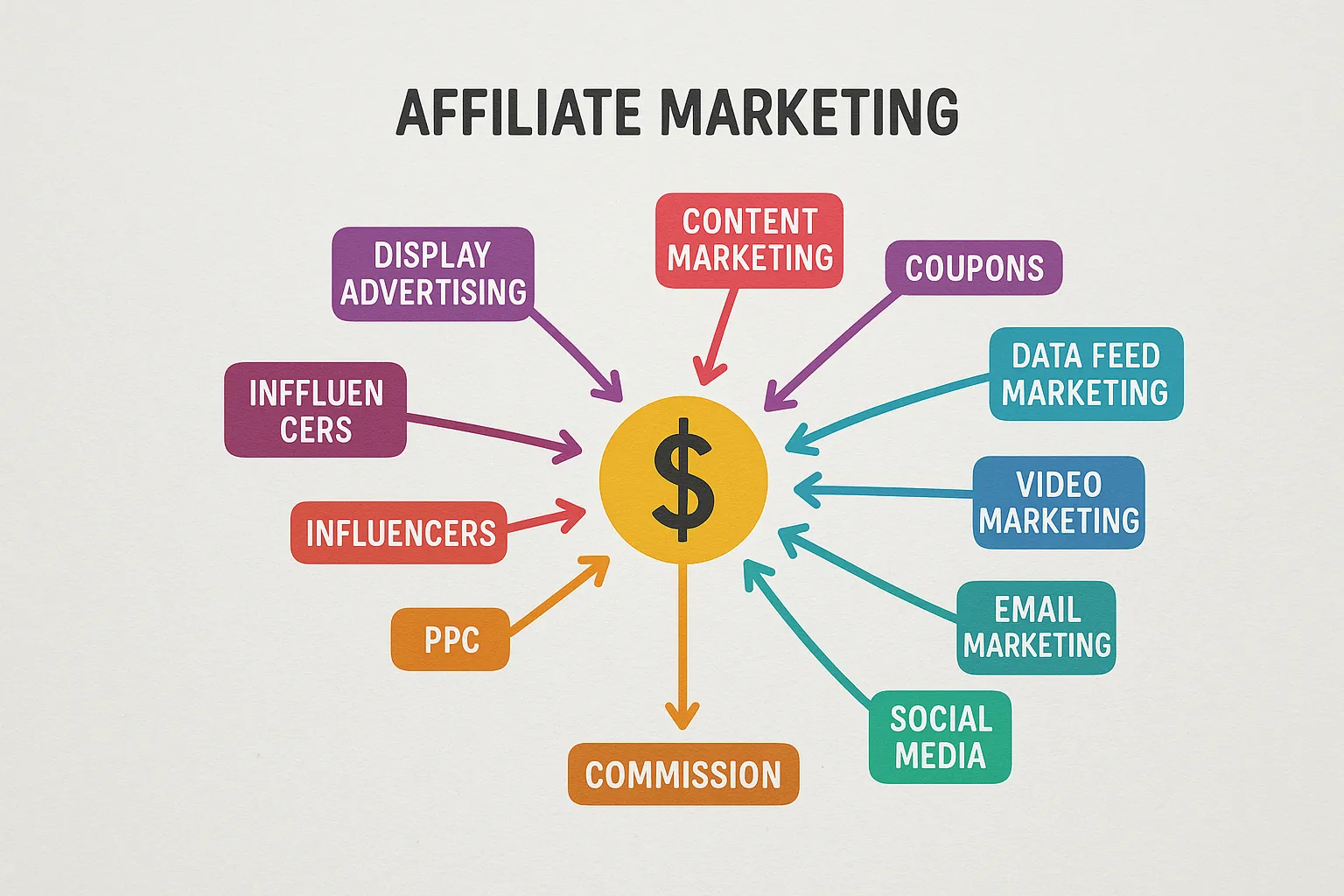
Affiliate marketing looks simple on paper—share a trackable link and earn a commission when someone buys. In practice, long-term success comes from stacking proven tactics rather than relying on one traffic source. Below are nine field-tested methods that top affiliates still use in 2025. Mix and match the ones that fit your skills, budget, and audience to create multiple revenue streams that compound over time.

Why Diversify Your Affiliate Strategy?
- Industry growth: Global affiliate spend is forecast to hit $17 billion by 2027 (Statista, 2023).
- Algorithm shifts: Google core updates, Instagram policy tweaks, and ad-platform changes can wipe out single-channel income overnight.
- Compounding reach: Each new channel introduces fresh prospects into your funnel and lets you retarget previous visitors.
If you’re brand-new to the business, start with our beginner playbook, “Unlocking Wealth: How to Make Money Online with Affiliate Marketing,” then circle back here for scalable tactics.
1. Authority Blog + Evergreen SEO
Blogging remains the highest-ROI approach for most affiliates because organic traffic compounds. To compete in 2025:
- Map search intent with tools like Ahrefs or LowFruits.
- Use information–comparison–transactional clusters to funnel readers toward product pages.
- Embed comparison tables and CTAs above the fold (e.g., Gutenberg or Kadence blocks on WordPress).
- Update content quarterly. Google’s Helpful Content System rewards freshness.
Pros: Passive traffic; builds brand equity.
Cons: 4–9 months to rank on competitive keywords.
Internal resource: Learn how AI accelerates content production in our post on making money online using AI.
2. Email Mini-Courses & Autoresponders
An engaged list converts 2–5× better than social traffic. Create a 5-day mini-course that solves a micro-problem, then soft-pitch an affiliate tool that extends the solution.
- Capture emails with pop-ups or lead magnets.
- Sequence: Value email → story email → product demo → limited-time bonus.
- Tools: Beehiiv, ConvertKit, or GetResponse.
Tip: Segmentation boosts earnings. According to Campaign Monitor, segmented campaigns drive 760 % higher revenue.
3. Review & Comparison YouTube Channel
Video reviews shorten the trust gap. Use face-to-camera intros, screen-share demos, and timestamps. Rank videos by optimizing the first 48 hours: CTR, watch time, and comments.
Monetization stacks: YouTube ads + description links + pinned comment.
Hardware: 1080p webcam, lapel mic, OBS Studio (free).
4. TikTok & Reels with Link-in-Bio Funnels
Short-form discovery is exploding. Drop 15- to 45-second “problem/tease/solution” clips.
- Add urgency with overlay text (e.g., “Free today only”).
- Route viewers to a Linktree or Stan Store containing affiliate offers.
- Recycle content across Instagram Reels and YouTube Shorts.
Stat: TikTok users spend 95 minutes daily on the app (DataReportal, 2025).
5. Live Webinars & Product Demos
Webinars convert at 10–20 % because attendees self-qualify. Partner with SaaS brands that offer joint webinars. Provide a workbook or template as a fast-action bonus via your affiliate link.
Structure:
- Pain-based hook (5 min)
- Teaching (30 min)
- Live demo (15 min)
- Q&A + urgency (10 min)
6. Bonus Stacking & Coupon Marketing
People love deals. Combine an official coupon with your own digital bonus (checklists, mini-courses) to tip the scale.
- Host bonus pages on a subdomain to avoid duplicate content issues.
- Use scarcity timers (Deadline Funnel) synced to visitor time zone.
- Verify that program terms allow coupons; Amazon Associates, for example, forbids third-party coupons.
7. Paid Traffic & Native Ads
If you have capital and data skills, paid traffic offers speed. Channels: Google Search, Microsoft Ads, Taboola, Outbrain.
Best practice: Direct link only to compliant bridge pages. Build retargeting audiences for higher-ticket offers.
Budget guideline: Start with $30/day to get statistically significant data.
8. Niche Communities, Forums, and Discord Servers
Community marketing builds high-intent referrals.
- Contribute 4–5 value posts for each link drop.
- Pin FAQs or resource channels with affiliate links.
- Respect platform rules; many allow “recommended tools” threads.
Case study: The r/PersonalFinance wiki accepts affiliate links if disclosed, leading to thousands of monthly clicks for top contributors.
9. Software + Content Bundle Partnerships
Bundle your digital product (templates, Notion dashboards) with a complementary SaaS. Example: Offer a Notion budget tracker free for anyone who subscribes to a personal-finance app via your link.
Benefits: Raises perceived value and differentiates you from other affiliates.
Side-by-Side Comparison
| Method | Startup Cost | Time to First Commission | Traffic Control | Scalability |
|---|---|---|---|---|
| Authority Blog | Low (domain, hosting) | 4–9 mo | Medium (SEO) | High |
| Email Funnels | Low–Med | 1–3 mo | High (owned) | High |
| YouTube Reviews | Medium (gear) | 2–4 mo | Medium | High |
| TikTok/Reels | Low | <1 mo | Low (algorithm) | Medium |
| Webinars | Low–Med | Weeks | High | Medium |
| Bonus & Coupons | Low | Days | Medium | Medium |
| Paid Traffic | High | Days | High | High |
| Communities | Low | Weeks | Low | Low–Med |
| Bundles | Low | Weeks | Medium | Medium–High |

Putting It All Together
- Pick one core content engine (blog or video).
- Layer an email funnel to own your audience.
- Add one diversification channel every quarter to hedge risk.
- Track every click with UTM parameters inside Google Analytics 4 or Fathom.
The more surfaces you occupy, the harder it is for algorithms—or competitors—to knock you out of the game.
Internal Tool Stack
- Content creation: Refer to our Best AI Tools for Online Success.
- Hosting: Choose from the options in Best 10 Web Hosting Companies.
Frequently Asked Questions
Which method is best for total beginners? Authority blogging combined with email capture gives you the most control and long-term upside without large upfront costs.
Is paid traffic still profitable in 2025? Yes—if you track conversions rigorously and reinvest only after hitting a positive return on ad spend (ROAS).
How long does it take to earn $1,000/month? Results vary, but affiliates who publish weekly content and build an email list typically hit that milestone within 6–12 months.
Ready to execute? Dive deeper with our step-by-step beginner guide “Unlocking Wealth: How to Make Money Online with Affiliate Marketing” and join the JYA-B newsletter for fresh tactics every week.
Leave a Reply